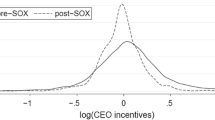Abstract
Previous research has suggested a relationship between the establishment of employee stock ownership plans (ESOPs) and post-adoption improvements in financial performance — presumably as a result of the alignment of employee and stockholder interests. I examine the role of tax incentives on the financial performance of ESOP firms. The results indicate that ESOPs formed prior to the availability of tax incentives provided by the Tax Reform Act of 1986 have experienced significantly greater improvement in financial performance than ESOPs established after passage of the Act. The results are consistent with my hypothesis and suggest that even though ESOPs can be utilized to reduce a firm's federal income tax liability, ESOPs may be more useful to management to reduce agency costs throughout the firm.
Similar content being viewed by others
References
Baysinger, Barry D., Rita D. Kosnik, and Thomas A. Turk. “Effects of Board and Ownership Structure on Corporate R&D Strategy.” Academy of Management Journal 34 (March 1991): 205–14.
Berle, Adolf A. and Gardiner C. Means. The Modern Corporation and Private Property. New York: Macmillan, 1932.
Bettis, Richard A. "Performance Differences in Related and Unrelated Diversified Firms.” Strategic Management Journal 2 (February 1981): 379–93.
Brown, Gregory K. "Overview of ESOP Legal Requirements.” In ESOPs: The Handbook of Employee Stock Ownership Plans. Gerald Kalish, ed. Chicago: Probus Publishing, 1989.
Buchko, Aaron A. "The Effects of Employee Ownership on Employee Attitudes: An Integrated Causal Model and Path Analysis.” Journal of Management Studies 30 (July 1993): 633–57.
Bull, Ivan. “Financial Performance of Leveraged Buyouts: An Empirical Analysis.” Journal of Business Venturing 4 (July 1989): 263–79.
Campbell, Donald T. and Julian C. Stanley. Experimental and Quasi-Experimental Designs for Research. Chicago: Rand McNally, 1963.
Chaganti, Rajeswararao and Fariborz Damanpour. “Institutional Ownership, Capital Structure, and Firm Performance.'' Strategic Management Journal 12 (October 1991): 479–91.
Conte, Michael A. and Arnold S. Tannenbaum. “Employee-Owned Companies: Is the Difference Measurable?" Monthly Labor Review 101 (July 1978): 23–28.
Curtis, John E. and Gregory K. Brown. “Using Deductible ESOP Dividends to Achieve Corporate Goals.” Journal of Pension Planning and Compliance 17 (Fall 1991): 60–66.
Davidson, Wallace N., III and Dan L. Worrell. “ESOP's Fables: The Influence of Employee Stock Ownership Plans on Corporate Stock Prices and Subsequent Operating Performance.” Human Resource Planning 17 (December 1994): 69–85.
"Encouraging Results from Major Ohio Study." Employee Ownership Report 13 (July/August 1993): 1, 4.
"ESOPs, Employee Ownership Evolve." Employee Benefit Plan Review 48 (August 1993): 28–30.
Hansen, Gary S. and Charles W. L. Hill. “Are Institutional Investors Myopic? A Time-Series Study of Four Technology-Driven Industries.” Strategic Management Journal 12(January 1991): 1–16.
Hill, Charles W. L. and Scott A. Snell. “External Control, Corporate Strategy, and Firm Performance in Research-Intensive Industries.” Strategic Management Journal 9 (November/December 1988): 577–90.
—. “Effects of Ownership Structure and Control on Corporate Productivity.” Academy of Management Journal 32 (March 1989): 25–46.
Hoskisson, Robert E., Michael A. Hitt, Richard A. Johnson, and D. D. Moesel. “Construct Validity of an Objective (Entropy) Categorical Measure of Diversification Strategy.” Strategic Management Journal 14 (March 1993): 215–35.
Hoskisson, Robert E. and Richard A. Johnson. “Corporate Restructuring and Strategic Change: The Effect on Diversification Strategy and R&D Intensity.” Strategic Management Journal 13 (November 1992): 625–34.
Jensen, Michael C. and William H. Meckling. “Theory of the Firm: Managerial Behavior, Agency Costs and Ownership Structure.” Journal of Financial Economics 3 (October 1976): 305–60.
Kaplan, Steven. “The Effects of Management Buyouts on Operating Performance and Value.” Journal of Financial Economics 24 (October 1989): 217–54.
Klein, Katherine J. "Employee Stock Ownership and Employee Attitudes: A Test of Three Models.” Journal of Applied Psychology 72 (May 1987): 319–32.
Livingston, D. Thomas and James B. Henry. “The Effect of Employee Ownership on Corporate Profits.” Journal of Risk and Insurance 47 (September 1980): 491–505.
Long, William F. and David J. Ravenscraft. “LBOs, Debt and R&D Intensity.” Strategic Management Journal 14 (Special Issue — Summer 1993): 119–35.
Oswald, Sharon L., William N. Pugh, and John S. Jahera, Jr. "An Empirical Analysis of Changes in Corporate Performance Following an ESOP Implementation." (Unpublished manuscript, 1992).
Pedhazur, Elazar J. Multiple Regression in Behavioral Research: Explanation and Prediction. Fort Worth, Tex.: Holt, Rinehart and Winston, 1982.
Pedhazur, Elazar J. and Liora P. Schmelkin. Measurement, Design, and Analysis: An Integrated Approach. Hillsdale, N. J.: Lawrence Erlbaum Associates, 1991.
"Research Studies Link Between Employee Ownership and Corporate Performance." Employee Benefit Plan Review 47 (July 1992): 14-15.
Rosen, Corey. “Ownership, Motivation, and Corporate Performance: Putting ESOPs to Work.” In ESOPs: The Handbook of Employee Stock Ownership Plans. Gerald Kalish, ed. Chicago: Probus Publishing, 1989.
— and Katherine J. Klein. “Job-Creating Performance of Employee-Owned Firms.” Monthly Labor Review 106 (August 1983): 15–19.
— and Michael Quarrey. “How Well Is Employee Ownership Working?" Harvard Business Review 65 (September/October 1987): 126–28, 132.
Schatz, Robert F. "Lending to ESOPs." In ESOPs: The Handbook of Employee Stock Ownership Plans. Gerald Kalish, ed. Chicago: Probus Publishing, 1989.
U.S. General Accounting Office. "Employee Stock Ownership Plans: Benefits and Costs of ESOP Tax Incentives for Broadening Stock Ownership." Report #GAO/PEMD-87, 1986.
Varadarajan, P. “Rajan" and Vasudevan Ramanujam. "Diversification and Performance: A Reexamination Using a New Two-Dimensional Conceptualization of Diversity in Firms.” Academy of Management Journal 30 (June 1987): 380–93.
Author information
Authors and Affiliations
Additional information
This paper is based on my Ph.D. dissertation completed at the University of Alabama. I sincerely appreciate the efforts of my dissertation chairman, Lawrence W. Foster, and committee members, M.M. Petty, Clyde J. Scott, Michael T. Dugan, and Bruce E. Barrett.
Rights and permissions
About this article
Cite this article
Gamble, J.E. ESOPS: Financial performance and federal tax incentives. J Labor Res 19, 529–541 (1998). https://doi.org/10.1007/s12122-998-1045-8
Issue Date:
DOI: https://doi.org/10.1007/s12122-998-1045-8



